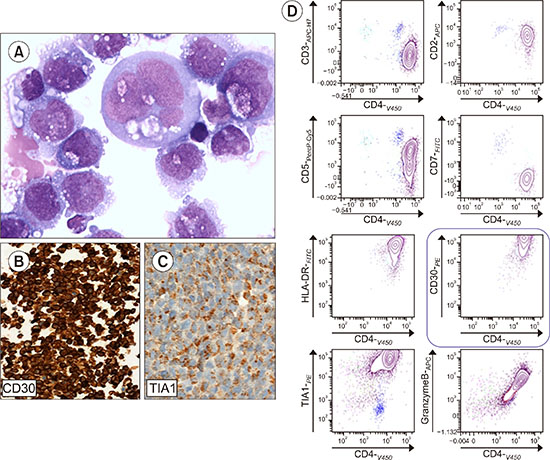
This article has been corrected. See "Erratum: Breast implant-associated anaplastic large cell lymphoma" in Volume 54 on page 157.

A 73-year-old woman with bilateral breast implants following mastectomies for cancer and a previous right-sided implant revision due to implant rupture presented to us with ultrasound-confirmed fluid accumulation around the left implant, without lymphadenopathy, splenomegaly, or B symptoms.
Cytological analysis of the seroma fluid (A, cytocentrifuge preparation; MGG stain, ×100) showed medium to large cells with anaplastic morphology, basophilic cytoplasm, round to more irregular nuclei, and clumped or dispersed chromatin with rare small nuclei. Cytoblock immunohistochemistry (IHC) stained negative for ALK and positive for CD3, CD30, and TIA-1 (B, C). Flow cytometry (FCM) immunophenotyping of the fluid identified large CD4+ T-cells with aberrant phenotype (failed CD3/CD7 and partial CD5 expression); CD30 and HLA-DR were strongly expressed, as well as cytoplasmic cytotoxic markers TIA1, granzyme B, and perforin [D, lymphoma T-cells (purple), residual T-cells (blue)]. Cellular morphology and immunologic profile pointed to a diagnosis of breast implant-associated anaplastic large cell lymphoma (BIA-ALCL).
BIA-ALCL, recently recognized in the 2016 World Health Organization Classification of Lymphomas, is often curable when diagnosed early. As recommended by the National Comprehensive Cancer Network (NCCN) guidelines, appropriate cytological examination of seroma fluid utilizing FCM and IHC, including CD30 and ALK staining, appears crucial to its diagnosis.




 PDF
PDF ePub
ePub Citation
Citation Print
Print


 XML Download
XML Download